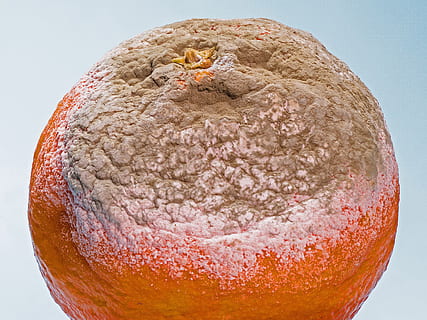无论你是那种一有机会就狼吞虎咽地吃蓝奶酪的人,还是那种不惜一切代价避免吃蓝奶酪的人,我们都可以在一件事上达成一致意见——花式奶酪中的蓝绿色纹理是意料之中的,但冰箱里草莓包装上的蓝绿色绒毛是令人畏惧和恶心的。但真的有很大区别吗?如果可以吃长毛奶酪,那浆果可以不扔吗?

While it's normal for certain foods to have mold on or in them – like the aforementioned cheeses, and dry-cured country hams – these molds are known to be either safe to eat (blue cheeses) or, in the case of ham, they can be safely washed off without affecting the meat. When it comes to mold on fruits though, it's a different story.
虽然某些食物上或里面有霉菌是正常的,比如上述奶酪和干腌乡村火腿,但众所周知,这些霉菌既可以安全食用(蓝色奶酪),也可以在不影响肉类的情况下被安全地清洗掉。但说到水果上的霉菌,情况就不同了。
Most experts agree that, if you eat a bite or two of a moldy apple before realizing your mistake, there's no need to panic. Dr. Rudolph Bedford, a gastroenterologist at Providence Saint John's Health Center in Santa Monica, told Women's Health, "It's very uncommon that you're going to get [really] sick from mold. The stomach is a harsh environment, so, for the most part, most bacteria and fungus won't survive."
大多数专家都同意,如果你在意识到错误之前吃了一两口发霉的苹果,就没有必要惊慌。圣莫尼卡普罗维登斯圣约翰健康中心的胃肠病专家鲁道夫·贝德福德博士告诉《妇女健康》杂志,“你会因为霉菌而[真的]生病是非常罕见的。胃是一个恶劣的环境,因此,在大多数情况下,大多数细菌和真菌都无法存活。”
That doesn't mean you shouldn't be careful though. Although it's rare, certain molds can be toxic and have the potential to make you really sick. And along with any visible mold on your fruit, there's probably another, invisible growth – bacteria – which can cause foodborne illness (via Cleveland Clinic).
但这并不意味着你不需要小心。虽然很罕见,但某些霉菌可能有毒,并有可能让你真的生病。除了水果上的任何可见霉菌外,可能还有另一种看不见的生长物——细菌——可以引起食源性疾病。
Soft fruits – think berries and stone fruits like peaches and apricots, among others – are especially prone to bacteria growth because of their high moisture content. That's why, while many hard, low-moisture products like hard cheese or carrots can usually still be safely eaten after carefully cutting the moldy section away, fruits can't. Dietitian Lillian Craggs-Dino notes "Fruit has a lot of moisture and this mold could also harbor bacteria. Toss the pack since the spores are airborne, and most likely the entire package is contaminated even though you don't see the fuzzy growth on all the fruit."
软性水果——比如浆果和核桃,比如桃子和杏子——因为水分含量高,特别容易滋生细菌。这就是为什么很多硬的、低水分的产品,比如硬奶酪或胡萝卜,在小心地把发霉的部分切掉之后,通常仍然可以安全食用,而水果就不行了。营养学家莉莲·克拉格斯-迪诺指出:“水果含有大量水分,这种霉菌也可能是细菌的温床。扔掉包装,因为孢子是通过空气传播的,很有可能整个包装都被污染了,即使你看不到所有的水果上都有霉菌的生长。”
Sure, it's hard to toss an entire package of fruit that just has a few moldy spots to it. But when it comes to mold and bacteria, it's better to err on the side of caution. John Ward, certified mold inspector and remediator in Ottawa, Canada, advises "The best advice I can give you is to use good judgment, and if you're still unsure about that punnet of berries, it's better to be safe than sorry and simply toss it away" (per Eat This, Not That!).
当然,如果一整包水果上只有几块发霉的斑点,那就很难都扔掉了。但当涉及到霉菌和细菌时,最好谨慎行事。加拿大渥太华的认证霉菌检查员和补救者约翰·沃德建议说:“我能给你的最好的建议是进行良好的判断,如果你仍然不确定那一篮子浆果,不用抱歉,最好干脆直接扔掉。”







